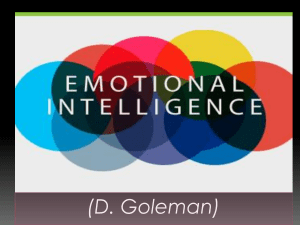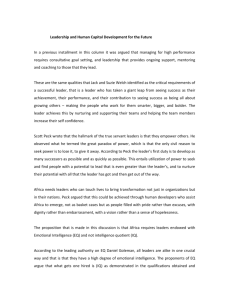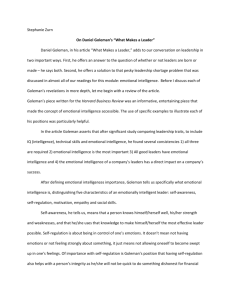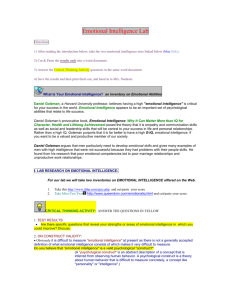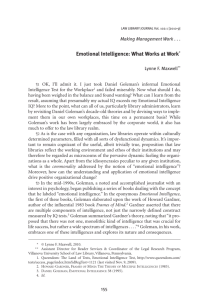Effective Communication
advertisement
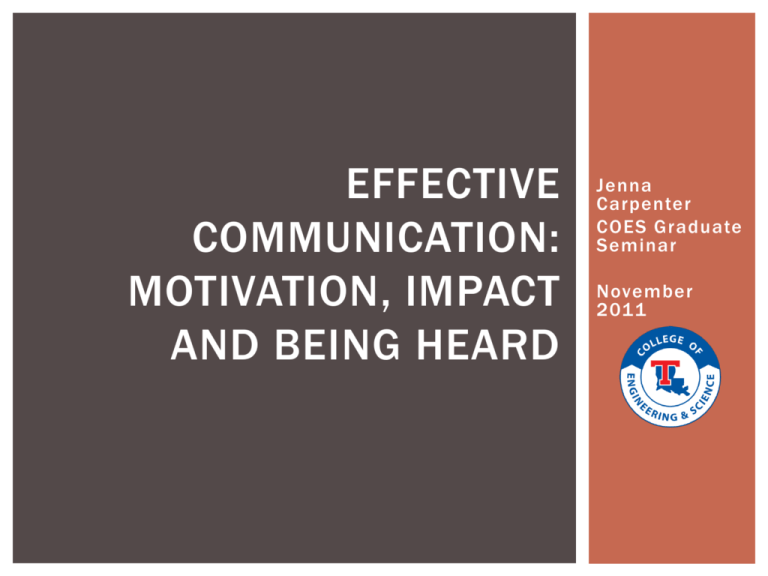
EFFECTIVE COMMUNICATION: MOTIVATION, IMPACT AND BEING HEARD Jenna Carpenter COES Graduate Seminar November 2011 OUTLINE • Motivation: EQ & Leadership • Impact of Communication Style • What’s your Style? • Strengths & Supports • Communicating with Other Styles • References ? EQ=EMOTIONAL INTELLIGENCE EQ or “Emotional Intelligence ” first appeared as a concept in 1940 (David Wechsler) and was made famous by Daniel Goleman in his landmark 1995 book “Emotional Intelligence” (Salovey and Mayer, 1990) “ Emotional intelligence refers to the capacity for recognizing our own feelings and those of others, for motivating ourselves, and for managing emotions well in ourselves and our relationships .” Daniel Goleman, Working with Emotional Intelligence , 1998 STUDIES: EQ AND LEADERSHIP “Rigidity, poor relationships, and inability to lead teams are the most common traits of executives who derail.” Center for Creative Leadership Study “Manager s who derailed all had high levels of exper tise and intelligence but many were arrogant and had a disdain for teamwork.” Egon Zehender Study A study of 100’s of executives at 15 global organizations (Pepsi, IBM, Vovlo, etc.) found that 2/3 of the competencies essential for success were emotional competencies . Hay McBer Study An analysis of 1 81 jobs in 1 21 organizations found that emotional competencies were the best dif ferentiators between star per formers and typical per former s. Daniel Goleman WHAT IS EMOTIONAL COMPETENCE? Structure of Emotional Competence 1 Self-Awareness Self-Management Social Awareness Relationship Management Emotional Intelligence is not as fixed as IQ. EQ can develop or improve over time. Participating in training, coaching, and feedback can significantly improve your EQ. 1 Primal Leadership, Daniel Goleman, HBS Press: 2002 HOW DO COMMUNICATION ST YLES LINK TO EQ? Knowing Your Communication Style and that of those around you helps you address three of the four Emotional Competencies: Self-Awareness Self-Management Relationship Management IMPACT OF COMMUNICATION ST YLES UNDERSTANDING YOUR COMMUNICATION ST YLE IMPACTS Self-Awareness & Self-Management: How you respond to conflict What motivates you What causes you stress How you solve problems UNDERSTANDING OTHERS’ COMMUNICATION ST YLES IMPACTS Relationship Management: Facilitates teamwork Improves interactions Helps you manage others more effectively Assists you in responding more efficiently WHAT’S YOUR ST YLE ? 1 Dominance Shape the environment by overcoming opposition to accomplish results Priorities: Get immediate results, take action, challenge self and others Influence Shape the environment by influencing or persuading others Motivation: Social recognition, disapproval, loss of influence, being ignored Steadiness Cooperate with others within existing circumstances to carry out the task Displays: Patience, team player, calm approach, good listener, humility Conscientiousness Work conscientiously within existing circumstances to ensure quality and accuracy Avoids: Social criticism, slipshod methods, errors 1. DiSC(c) is a registered trademark of Inscape Publ., Inc. TAKE THE COMMUNICATION ST YLE SURVEY! Rank the words in each row from 1 – 4 with 1 = word that describes you the least, 4 = word that describes you the most. Total each column. Decisive Goal Driven Daring Takes Charge Demanding Forceful Risk Taker Adventuresome Direct Argumentative Control Variety Self-Reliant Total:__________ Optimistic Self-Promoting Impulsive Emotional Influential Persuasive Sociable Spontaneous Upbeat Fun-Loving Enjoys Change Non-structured Enthusiastic Total:__________ Reserved Serene Predictable Comfortable Peaceful Complacent Content Relaxed Even Keel Patient Harmonious Routine Team Person Total:__________ Deliberate Perfectionist Systematic Courteous Restrained Diplomatic Practical Organized Serious Logical Orderly Structured Analytical Total:__________ SURVEY RESULTS Look at the four column totals for your survey. The two highest totals represent your primary strengths (sometimes people have three totals that are very close together instead of just two). The first column measures “Dominance” style, the second column measures “Influence” style, the third column measures “Steady” style and the fourth column measures “Conscientious” style. Now that you know your communication style preferences, let learn what strengths they give you, how they impact your motivation, the types of support skills you need to seek in others, and what items you can work on to improve your skills! SURVEY SUMMARY Dominance Fast-Paced Moderate-Paced Conscientiousness Perfectionist, Accurate, Diplomatic, Systemic, Courteous, High Standards Enthusiastic, Impulsive, Emotional, Self-Promoting, Trusting, Influential, Sociable People-Focused Task-Focused Direct, Daring, Domineering, Demanding, Risk-Taker, Adventuresome, Decisive Influencing Steadiness Peaceful, Patient, Loyal, Predictable, Team-Person, Serene, Possessive, Reserved STRENGTHS AND SUPPORTS STRENGTHS AND SUPPORTS STRENGTHS AND SUPPORTS STRENGTHS AND SUPPORTS STOP AND THINK OF THOSE AROUND YOU FastPaced TaskFocused Direct, Daring, Domineering, Demanding, Risk-Taker, Adventuresome, Decisive Influencing Perfectionist, Accurate, Diplomatic, Systemic, Courteous, High Standards Enthusiastic, Impulsive, Emotional, Self-Promoting, Trusting, Influential, Sociable PeopleFocused Dominance Peers Staff Administrators Collaborators Students Conscientiousness Family ModeratePaced Steadiness Peaceful, Patient, Loyal, Predictable, Team-Person, Serene, Possessive, Reserved COMMUNICATING WITH OTHERS High “D” People Be logical, direct, to the point, brief Stick to business Highlight data important to the situation (don’t overuse) Focus on win/win situation High “C” People Focus on task, not people side Supply supporting data to answer “whys” Focus on quality Have an organized approach COMMUNICATING WITH OTHERS High “I” People Allow for a few minutes of “social” time at the beginning Focus on the impact on the people Don’t get into details too much – give enough to get the point across Give responses quickly High “S” People Be patient – they need time to internalize Involve them early in discussions Ask for their opinions – especially if high “D’s” are around Describe the benefits for them QUESTIONS? References: “Emotional Intelligence,” http://en.wikipedia.org/wiki/Emotional_intelligence, accessed October 30, 2011. “Daniel Goleman,” http://en.wikipedia.org/wiki/Daniel_Goleman, accessed October 30, 2011. Dattner, Ben, “Succeeding With Emotional intelligence,” http://www.dattnerconsulting.com/presentations/ei.pdf, accessed October 30, 2011. Grindstaff, Lynda, “Effective Communication: What’s Your Style?”, SWE WE 11 Conference, October, 2011. “What is DiSC©?”, Inscape Publishing Company, http://www.discprofile.com/whatisdisc.htm, accessed October 30, 2011.
